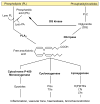Bioactive lipids in Trypanosoma cruzi infection
- PMID: 21884885
- PMCID: PMC3564251
- DOI: 10.1016/B978-0-12-385895-5.00001-3
Bioactive lipids in Trypanosoma cruzi infection
Abstract
Chagas disease is caused by Trypanosoma cruzi, a protozoan parasite. Chagas disease remains a serious health problem in large parts of Mexico and Central and South America, where it is a major cause of morbidity and mortality. This disease is being increasingly recognized in non-endemic regions due to immigration. Heart disease develops in 10-30% of infected individuals. It is increasingly clear that parasite- and host-derived bioactive lipids potently modulate disease progression. Many of the changes that occur during acute and chronic Chagas disease can be accounted for by the effects of arachidonic acid (AA)-derived lipids such as leukotrienes, lipoxins, H(P)ETEs, prostaglandins (PGs) and thromboxane. During the course of infection with T. cruzi, changes in circulating levels of AA metabolites are observed. Antagonism of PG synthesis with cyclooxygenase (COX) inhibitors has both beneficial and adverse effects. Treatment with COX inhibitors during acute infection may result in increased parasite load and mortality. However, treatment instituted during chronic infection may be beneficial with no increase in mortality and substantial improvement with cardiac function. Recently, T. cruzi infection of mice deficient in AA biosynthetic enzymes for various pathways has yielded more insightful data than pharmacological inhibition and has highlighted the potential deleterious effects of inhibitors due to "off-target" actions. Using COX-1 null mice, it was observed that parasite biosynthesis is dependent upon host metabolism, that the majority of TXA(2) liberated during T. cruzi infection is derived from the parasite and that this molecule may act as a quorum sensor to control parasite growth/differentiation. Thus, eicosanoids present during acute infection may act as immunomodulators aiding the transition to, and maintenance of, the chronic stage of the disease. It is also likely that the same mediators that initially function to ensure host survival may later contribute to cardiovascular damage. Collectively, the eicosanoids represent a new series of targets for therapy in Chagas disease with defined potential therapeutic windows in which to apply these agents for greatest effect. A deeper understanding of the mechanism of action of non-steroidal anti-inflammatory drugs may provide clues to the differences between host responses in acute and chronic T. cruzi infection.
Copyright © 2011 Elsevier Ltd. All rights reserved.
Figures
Similar articles
-
Aspirin treatment of mice infected with Trypanosoma cruzi and implications for the pathogenesis of Chagas disease.PLoS One. 2011 Feb 15;6(2):e16959. doi: 10.1371/journal.pone.0016959. PLoS One. 2011. PMID: 21347238 Free PMC article.
-
Cardioprotective actions of curcumin on the pathogenic NFAT/COX-2/prostaglandin E2 pathway induced during Trypanosoma cruzi infection.Phytomedicine. 2016 Nov 15;23(12):1392-1400. doi: 10.1016/j.phymed.2016.06.017. Epub 2016 Jun 29. Phytomedicine. 2016. PMID: 27765359
-
Thromboxane A2 is a key regulator of pathogenesis during Trypanosoma cruzi infection.J Exp Med. 2007 Apr 16;204(4):929-40. doi: 10.1084/jem.20062432. Epub 2007 Apr 9. J Exp Med. 2007. PMID: 17420269 Free PMC article.
-
Nonsteroidal Anti-Inflammatory Drugs and Experimental Chagas Disease: An Unsolved Question.Parasite Immunol. 2024 Jul;46(7):e13057. doi: 10.1111/pim.13057. Parasite Immunol. 2024. PMID: 39008292 Review.
-
Mechanisms of Trypanosoma cruzi persistence in Chagas disease.Cell Microbiol. 2012 May;14(5):634-43. doi: 10.1111/j.1462-5822.2012.01764.x. Epub 2012 Feb 24. Cell Microbiol. 2012. PMID: 22309180 Free PMC article. Review.
Cited by
-
Fatty Acid Composition and Metabolism in Leishmania Parasite Species: Potential Biomarkers or Drug Targets for Leishmaniasis?Int J Mol Sci. 2023 Feb 28;24(5):4702. doi: 10.3390/ijms24054702. Int J Mol Sci. 2023. PMID: 36902138 Free PMC article. Review.
-
Combination Therapy Using Benznidazole and Aspirin during the Acute Phase of Experimental Chagas Disease Prevents Cardiovascular Dysfunction and Decreases Typical Cardiac Lesions in the Chronic Phase.Antimicrob Agents Chemother. 2020 Jun 23;64(7):e00069-20. doi: 10.1128/AAC.00069-20. Print 2020 Jun 23. Antimicrob Agents Chemother. 2020. PMID: 32366719 Free PMC article.
-
Trypanosoma cruzi infection and endothelin-1 cooperatively activate pathogenic inflammatory pathways in cardiomyocytes.PLoS Negl Trop Dis. 2013;7(2):e2034. doi: 10.1371/journal.pntd.0002034. Epub 2013 Feb 7. PLoS Negl Trop Dis. 2013. PMID: 23409199 Free PMC article.
-
Trypanosoma cruzi Produces the Specialized Proresolving Mediators Resolvin D1, Resolvin D5, and Resolvin E2.Infect Immun. 2018 Mar 22;86(4):e00688-17. doi: 10.1128/IAI.00688-17. Print 2018 Apr. Infect Immun. 2018. PMID: 29358332 Free PMC article.
-
Drug repurposing for Chagas disease: In vitro assessment of nimesulide against Trypanosoma cruzi and insights on its mechanisms of action.PLoS One. 2021 Oct 22;16(10):e0258292. doi: 10.1371/journal.pone.0258292. eCollection 2021. PLoS One. 2021. PMID: 34679091 Free PMC article.
References
-
- Abdalla GK, Faria GE, Silva KT, Castro EC, Reis MA, Michelin MA. Trypanosoma cruzi: the role of PGE2 in immune response during the acute phase of experimental infection. Exp Parasitol. 2008;118:514–521. - PubMed
-
- Aliberti J. Host persistence: exploitation of anti-inflammatory pathways by Toxoplasma gondii. Nat Rev Immunol. 2005;5:162–170. - PubMed
-
- Aliberti J, Hieny S, Reis e Sousa C, Serhan CN, Sher A. Lipoxin-mediated inhibition of IL-12 production by DCs: a mechanism for regulation of microbial immunity. Nat Immunol. 2002b;3:76–82. - PubMed
-
- Andrade HM, Murta SM, Chapeaurouge A, Perales J, Nirde P, Romanha AJ. Proteomic analysis of Trypanosoma cruzi resistance to Benznidazole. J Proteome Res. 2008;7:2357–2367. - PubMed
Publication types
MeSH terms
Substances
Grants and funding
LinkOut - more resources
Full Text Sources
Other Literature Sources
Medical


